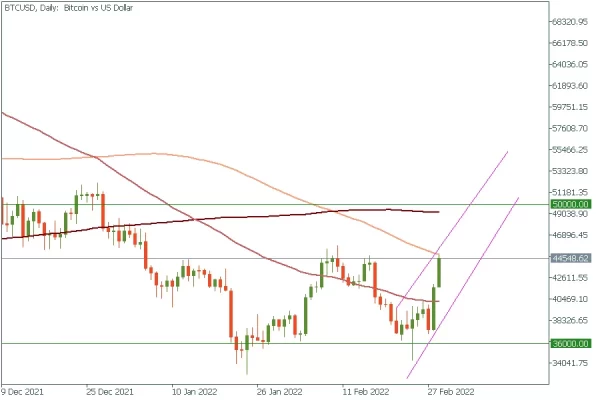Russia may turn to cryptocurrency when it is banned from the SWIFT payment system. Analysts warn that if Russia is able to use crypto to circumvent sanctions, “political support for crypto in the US will fall and regulatory risks will increase.”
What happened with Bitcoin?
Bitcoin defied the stock market plunge on Monday, climbing 9.3% amid what analysts said was increased demand from buyers in Russia and Ukraine. The cryptocurrency is trading at around $43,000, according to CoinDesk data. Ethereum gained about 11% over the past 24 hours, trading at approximately $2,900.
Is Bitcoin a new Detour?
During the last five days, when the Russian invasion began, transactions on centralized Bitcoin exchanges in both the Russian ruble and the Ukrainian hryvnia have surged to their highest levels in months, according to crypto data company Kaiko. Since Sunday, total cryptocurrency donations to the Ukrainian government and non-governmental organizations supporting the military stood was about $16.7 million.
Russians are aware of the volatility of their currency, and the financial system may see Bitcoin as a way to protect their savings. On Monday, Bitcoin traded on some Russian exchanges for $46,000, about $5,000 more than its US price. There is usually no difference between the Russian and US price of bitcoin because there are arbitrage possibilities; it indicates that such a jump in the price of Bitcoin is caused by buying in Russia.
Can crypto exchanges block Russian users?
However, when Ukraine’s vice prime minister Mykhailo Fedorov urged crypto exchanges on Sunday to block Russian users, Binance, KuCoin and other major crypto exchanges refused.
“We are not going to unilaterally freeze millions of innocent users’ accounts,” a spokesperson for Binance told CNBC. “Crypto is meant to provide greater financial freedom for people across the globe. To unilaterally decide to ban people’s access to their crypto would fly in the face of the reason why crypto exists.”
Why can Russia use it?
Now, it’s supposed that Russia can decide to use cryptocurrencies in commodities deals. However, most of the world trading is still dollar-dominated. As a result, it will be difficult for Russia to use crypto to evade SWIFT.
However, if Russia fails to use the cryptocurrency to bypass sanctions, this could increase the viability of the cryptocurrency in the eyes of regulators. Either way, the future looks interesting for Bitcoin and Co because the events can push crypto to occupy a more visible place in the global financial system.
What’s next for Bitcoin price?
As BTC/USD rebounded from $33,500 and is trying to form a ‘double bottom’, some analysts have started to expect the advance to $50,000 and $51,000. That would be the middle of the range, in which Bitcoin has been trading since the start of 2021. Given the things we’ve outlines in this article, we consider such a scenario quite realistic. Support for BTC/USD is located at $36,000/$35,000.














